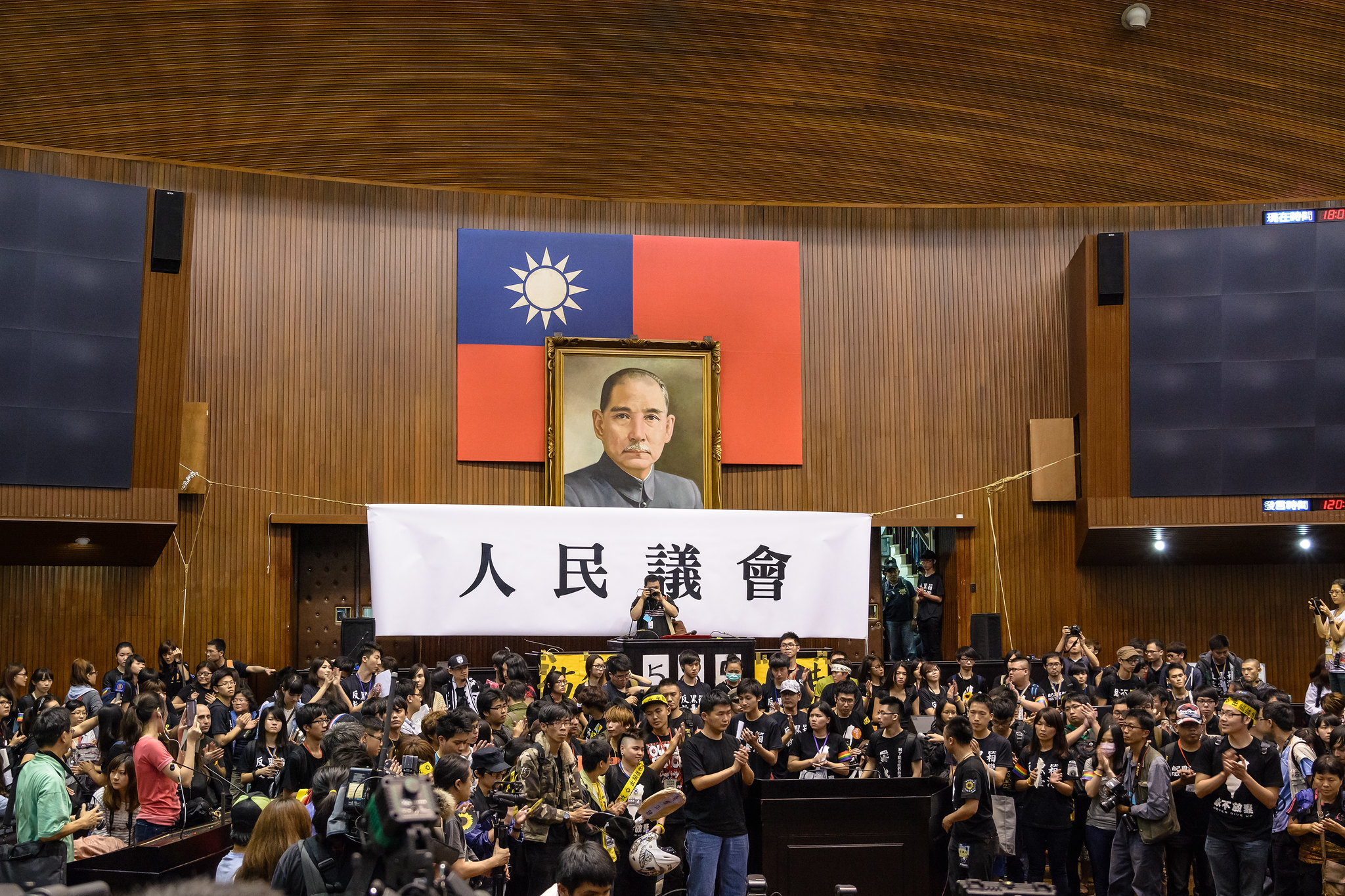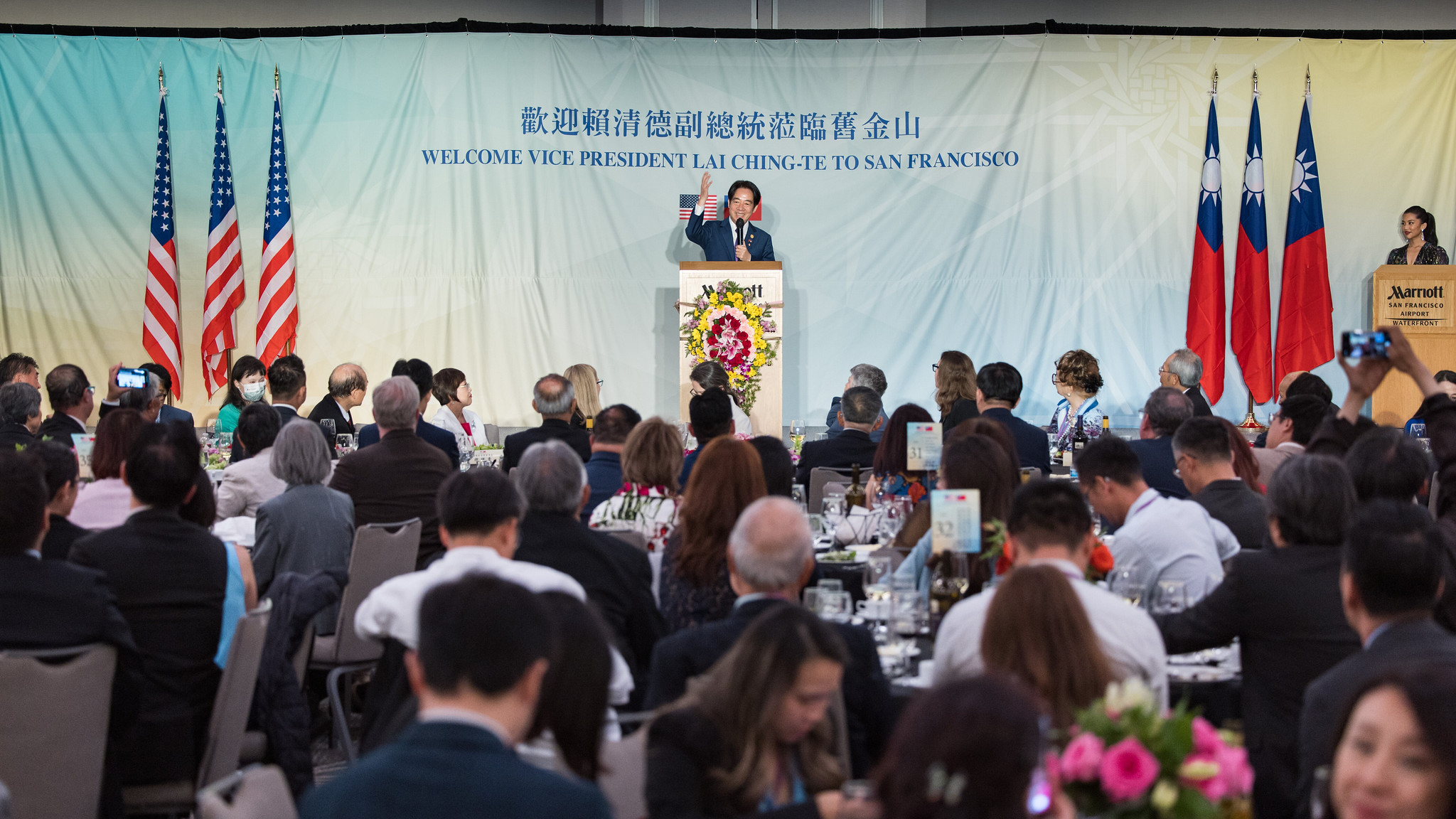How the China Cleavage Shapes Taiwan’s Elections
China’s long-running territorial disputes regarding Taiwan and the South China Sea have become two of Asia’s biggest flashpoints. How to keep them from igniting into military conflict? This Clingendael Spectator series looks beyond the headlines of these flashpoints. In the fourth episode, Clingendael expert Sense Hofstede analyses Taiwan’s electoral dynamics leading up to the January 2024 elections. The outcome of the votes will shape the direction of the island amidst the growing turbulence in the waters surrounding China.
On 13 January 2024, the Taiwanese electorate heads to the polling booths. The voters will elect a new parliament and a new president. Their choices will determine the island’s course in the increasingly choppy waters off China.
The incoming government will face the existential challenge of Xi Jinping’s assertive policies claiming that Taiwan should be part of its territory. A similar claim over the islets and reefs of the neighbouring South China Sea adds to regional tension.1 Taiwan’s strategic location at the centre of the Indo-Pacific – commandeering trade routes and defence lines – makes it a focal point of the contention between the United States and China.2
As this turbulence increases, there is a growing consensus among the Taiwanese people about who they are. However, their opinions diverge on Taiwan’s geopolitical position in the world. Where voters place Taiwan on the geopolitical map in January will also reverberate in Europe.3 Beyond guaranteeing reliable semiconductor supplies, the stability around Taiwan holds significant economic, political, and humanitarian implications.
To comprehend the electoral dynamics, it is important to understand two things. First, voters generally agree that they are Taiwanese. Second, the determining factor in Taiwanese politics is not the right-left divide as we know in Europe, but the so-called ‘China Cleavage’ – the split attitude towards Taiwan’s national identity and how this identity relates to China.
In January, nearly 20 million Taiwanese voters will have a choice between three political parties: the governing Democratic Progressive Party (DPP), the main opposition Chinese Nationalist Party (KMT) and the new Taiwan People’s Party (TPP). Each party represents a different position relative to the China Cleavage.
In the run-up to the elections, this article provides some background on the pivotal China Cleavage, which has become mainly about Taiwan’s attitude towards Beijing. It then analyses the three political parties participating in the elections. Where do they stand in relation to the China Cleavage? Finally, the analysis shifts it focus to those faced with the choice among these options: the voters.
Taiwanese know who they are
Taiwan’s electorate has always been less polarised than the fierce appearance of its competitive political landscape and contentious press suggests.4
Political parties, aiming for power, strategically position themselves by playing to a broad political centre that skews increasingly Taiwanese.
Survey results show that more than sixty per cent of Taiwan’s population currently identify as Taiwanese only. The remainder identifies as both Taiwanese and Chinese, except for a negligible 2.5 per cent who identify solely as Chinese.5 Taiwanese live in an independently functioning state they refer to as either the ‘Republic of China’ (ROC) or ‘Taiwan’, which most think is in any case independent from the Chinese Communist Party (CCP)’s People’s Republic of China (PRC).6
With the elimination of domestic dictatorship, the China Cleavage has become more about Taiwan’s attitude to Beijing
Whether ROC or Taiwan, its people want to maintain its sovereignty. There is an overwhelming rejection of specific Chinese proposals that suggest integration into the PRC.7 Less than 8 per cent express a desire for a more general idea of immediate or future unification with China.8 The majority supports what the surveys call the “status quo”.
Yet, the frequent bandying about of the term ‘status quo’ conceals the evolving comprehension of its meaning. The political movement that gave rise to the ruling DPP emerged in response to the bloody dictatorship of the KMT, marked by systematic discrimination against the majority of Taiwanese descended from those living there before 1945.9 This movement advocated for the overthrow of the ROC – calling for ‘independence’ – and democratisation.
However, since the end of the Cold War, the ROC has become democratic and its symbols more aligned with Taiwanese culture. This shift has diminished the sense of urgency for formal independence among Taiwanese nationalists. Almost ninety per cent of respondents now treat the once polarising formal name of the state, ‘Republic of China’, as generally synonymous with ‘Taiwan’.6
With the elimination of domestic dictatorship, the China Cleavage has become more about Taiwan’s attitude to Beijing.
The choices
Between 1945 and 2000, Taiwan was ruled by one party: the Chinese Nationalist Party (KMT). Rebuilt from the remnants of the KMT that was defeated by the CCP in 1949 and local factions on Taiwan, the subsequent Taiwanese KMT governed the island with iron fist under a bloody martial law regime underpinned by their brand of Chinese nationalism that ended with democratisation over the course of the 1990s.
In Taiwanese politics, the KMT’s side of the China Cleavage is known as the ‘Blue Camp’. The KMT no longer seeks to “retake the Mainland”, but it continues to prioritise Taiwan’s connections with China. However, their much-touted campaign argument that Beijing does engage in dialogue with the KMT stems from the party’s willingness to use unpopular terminology implying that Taiwan is part of ‘China’.10
The evolution of Taiwanese identity has shifted the midpoint of the China Cleavage away from the Blue Camp.11 In national elections, there is an inherent advantage for the so-called ‘Green Camp’, which is centred around the ruling DPP.
Current president Tsai Ing-wen (in office since 2016) upholds what some call the ‘Tsai Doctrine’.12 According to Tsai, Taiwan does not need to formally declare independence because the status quo is independence and sovereignty as the ROC.13 Vice President Lai Ching-te, who is the DPP’s candidate in the upcoming elections,14 supports this understanding.15
Determining where one wishes to stand also hinges on one’s risk appetite
This definition of the status quo is in line with the majority view.16 Tsai’s claim that the ROC and PRC are not subordinate to each other17 was supported by a 70.6 per cent majority in a poll from 2021.18 Nevertheless, the Blue Camp sees an opportunity in addressing concerns about the optimal approach to preserving Taiwan’s separate existence and economic well-being. Determining where one wishes to stand also hinges on one’s risk appetite.
Tsai’s government has pursued closer ties with the US and Japan, economic diversification away from China, and military modernisation. In response, the opposition has accused the DPP of betraying Taiwan,19 wasting economic opportunities, and risking war.20 KMT’s candidate Hou Yu-ih presents himself as the safe choice between the two ‘extremes’ of the DPP and CCP.21 His campaign claims the choice between DPP and KMT is one between war and peace.22 The Chinese government uses the same rhetoric.23
Nonetheless, the most effective opposition criticism centres on accusations of government corruption and incompetence. Many voters are unhappy with rising living costs and uncertain future prospects. After eight years of DPP governance, the majority wants a change of government.24 However, many do not trust the KMT either. The old party struggles to avert financial and ideological bankruptcy.25 This paves the way for new forces beyond the confines of the established two-party system.
The Taiwan People’s Party (TPP), established in 2019 and led by former Taipei mayor Ko Wen-je, tries to distinguish itself from the “ideological” squabbling of the ‘green’ DPP and ‘blue’ KMT. Positioned as a ‘white’ party that focusses on people’s livelihood, the TPP accuses the DPP of jeopardising peace and the KMT of bowing to China. Ko claims to be pragmatic rather than “political”, although his party’s stance on China is better described as ‘light blue’.
The voters
Voters are pretty clear that Taiwan is different from China. The point of contention is how different it should be. Similar to how many US voters shape their views through Democratic or Republican alignment (rather than the other way around), political scientists observe that Taiwanese voters formulate their opinions based on their relation to ‘China’, the China Cleavage.26
Over the decades, the meaning of that ‘China’ in Taiwanese usage has evolved, shifting from an inclusive reference including Taiwan to being generally about the PRC or Mainland China.27 In the past, the term ‘China’ was not as politicised as it is now. The rivalry between KMT and DPP initially revolved around the legacy of the ROC. Both parties endorsed economic engagement with China.
However, KMT President Ma Ying-jeou’s (2008-2016) agenda of economic integration with China went further than society was able to accept.28 That triggered a series of paradigm-shifting protests, culminating in the 2014 Sunflower Movement, when students occupied the legislature for weeks.29 Meanwhile, Chinese President Xi Jinping (2012-present) accelerated the assertive nationalist turn in Chinese foreign policy that had begun in 2008.

Since then, Taiwan’s relation with China has come to shape the China Cleavage. This is not about unification. While there may be room for speculation regarding the ultimate motives of Chinese nationalists within the Blue Camp,30 every serious political party – at least publicly – opposes Taiwan joining the PRC. Doing otherwise would be electoral suicide.
In a 2020 poll testing hypothetical scenarios, two-thirds of respondents expressed support for formal independence if peace were guaranteed.31 However, the Taiwanese electorate knows the risk of war with China. Support for formal independence, less urgent in modern Taiwan anyway, has come down in recent years to around a combined 25 per cent. A clear majority of the population supports the status quo.8
The Green and Blue camps can rely on a secure base of independence supporters and opponents respectively. But the status quo supporters cast the deciding vote. The party that successfully manages to convince enough of this part of the Taiwanese electorate will win in January 2024.
The competition for support from the middle voter puts pressure on candidates to distance themselves from Chinese demands
Polling shows that antipathy against the KMT has declined.32 Ko Wen-je has strong appeal among younger voters who normally would go for the pro-Taiwanese option.33 DPP candidate Lai maintains a plurality in many polls up to now, although not a majority.34
The three-way contest for the Taiwanese presidency echoes the elections in the pivotal year 2000. Chen Shui-bian brought the DPP into the presidential office for the first time thanks to a split vote. However, he had to govern while Blue Camp opposition parties used their blocking majority in parliament.35
A replay of that scenario is now on the horizon. In the two-thirds of the seats elected via single-member districts, local concerns as well as economic considerations will weaken the China Cleavage’s benefits for the Green Camp. Polling shows the DPP is weak in the remaining one third elected via party list vote as well. Even if Lai wins the presidency, the legislative majority hangs in the balance.36
A return to the gridlock?
Under any conceivable scenario, political integration with the PRC is not a viable option; a majority of Taiwanese would never accept it.37
The competition for support from the middle voter puts pressure on candidates to distance themselves from Chinese demands.38
The Green Camp campaigns on keeping Taiwan safe from China, while candidates from the Blue Camp invoke the spectres of corruption and war.
In contrast to the Taiwanese view, for Beijing the ‘status quo’ means that Taiwan is legally part of the PRC, but that Beijing is for now unable to exercise its administrative control in practice. Chinese statements consistently assert that the country maintains control over the situation, implying it is not in a hurry yet.39

However, Beijing is already “implementing an increasingly aggressive campaign of coercion without violence against Taiwan”.40 Beijing’s angry response to DPP candidate Lai Ching-te’s travel to the US stands in stark contrast to its acceptance of KMT’s Hou Yu-ih’s visit to the US, underscoring what outcome Beijing prefers.
A KMT or TPP victory would see a turn away from the US-centred and Japan-friendly foreign policy of Tsai Ing-wen. The new president’s attempts to create conditions for dialogue with Beijing could move beyond recognising that Taiwan is part of a ‘China’. So far, Taipei has joined tech sanctions against Russia and is not strongly pushing back against American attempts to control semiconductor technology export to China. That could change.
Taiwan faces serious domestic challenges that extend beyond cross-Strait politics. To effectively address issues such as bureaucratic reform, military modernisation, and climate challenges, a president will need cooperation from parliament. In a country unused to coalition governments and with a history of obstructionism from both sides, but especially the KMT, there is a possibility of a return to the gridlock of the Chen years.
- 1Vera Kranenburg and Nick Bontenbal, ‘Rising South China Sea tensions and concerns for Europe’, Clingendael Spectator, 23 August 2023.
- 2Sense Hofstede, ‘Risico op escalatie Indo-Pacific met Chinese druk op Taiwan’, Clingendael Spectator, 9 December 2020.
- 3Xiaoxue Martin, ‘Why the European inconsistency on Taiwan is a concern’, Clingendael Spectator, 23 May 2023.
- 4Austin Horng-En Wang, ‘The Myth of Polarisation among Taiwanese Voters: The Missing Middle’, Journal of East Asian Studies, vol. 19 no. 3, pp. 275-87.
- 5Election Study Center, NCCU, ‘Changes in the Taiwanese/Chinese Identity of Taiwanese as Tracked in Surveys by the Election Study Center, NCCU (1992~2023.6)’, 12 July 2023.
- 6 a b Fang-Yu Chen, Austin Wang, Charles K.S. Wu, and Yao-Yuan Yeh, ‘What Do Taiwan’s People Think About Their Relationship to China?’, The Diplomat, 29 May 2020.
- 7Mainland Affairs Council, Republic of China (Taiwan), ‘Mainstream Public Voice Support: Taiwan’s Option Is to Become Stronger, More United, and More Determined to Defend Itself’, 9 september 2021’.
- 8 a b Election Study Center, NCCU, ‘Changes in the Unification – Independence Stances of Taiwanese as Track in Surveys by Election Study Center, NCCU (1994~2022)’, 13 January 2023.
- 9The six million Taiwanese who lived on the island in 1945 and their descendants were referred to as běnshěngrén. The almost one million Chinese who came with Chiang Kai-shek and their descendants were called Mainlanders or wàishěngrén. See Dominic Meng-Hsuan Yang’s The Great Exodus from China (2020) for the history of the rise and fall of these contentious terms and the source of these numbers.
- 10Kayleigh Madjar, ‘Majority oppose “one China,” “1992 consensus”’,Taipei Times, 28 October 2022, p. 3
- 11Nathan F. Batto, ‘Cleavage Structure and the Demise of a Dominant Party: The Role of National Identity in the Fall of the KMT in Taiwan’, Asian Journal of Comparative Politics, vol. 4, no. 1, 2019, pp. 81–101.
- 12Tzou Jiing-wen, ‘Forming a “Tsai Ing-wen” doctrine’, Taipei Times, 20 October 2021, p. 8.
- 13John Sudworth, ‘China needs to show Taiwan respect, says president’, BBC News, 14 January 2020.
- 14Tsai Ing-wen cannot run again after her second term ends due to term limits.
- 15Cindy Wang, and Joel Weber, ‘Taiwan’s Election Is All About War Lai Ching-te, the vice president, is ahead in the polls. Can he keep the peace with Beijing?’, Bloomberg, 15 August 2023.
- 16Fang-Yu Chen, Wei-ting Yen, Austin Horng-en Wang, and Brian Hioe, ‘The Taiwanese see themselves as Taiwanese, not as Chinese’, The Washington Post, 2 January 2017.
- 17Tsai Ing-wen, ‘President Tsai delivers 2021 National Day Address’, Office of the President, Republic of China (Taiwan), 10 October 2021.
- 18Chen Yu-fu, ‘Republic of China and People’s Republic of China not mutually subordinate: 70.6% of Taiwan’s public supports’, Liberty Times, 18 October 2021.
- 19John Dotson, ‘Chinese Information Operations against Taiwan: The “Abandoned Chess Piece” and “America Skepticism Theory”’, Washington, DC: Global Taiwan Institute, August 2023.
- 20Lin Hsin-han, ‘DPP China policy is confrontation, not peace: KMT’, Taipei Times, 21 August 2023, p. 3.
- 21Hou Yu-ih, ‘Taiwan’s Path Between Extremes’, Foreign Affairs, 18 september 2023.
- 22CNA, ‘KMT’s Hou-Jaw ticket calls election a choice between war and peace’, Focus Taiwan, 26 November 2023.
- 23‘Lai hypes Taiwan-related content of San Francisco summit to whitewash separatist image: spokesperson’, The Global Times, 21 November 2023.
- 24‘Citizen support for DPP’s continuing in complete power in 2024 (21 October 2023)’, Taiwanese Public Opinion Foundation, 21 October 2023.
- 25In part, this situation is caused by the exposure of its unsavoury history through the opening of the archives by the Transitional Justice Commission. But the biggest blow is to its finances, thanks to the Ill-Gotten Party Assets Settlement Commission’s seizure of billions worth of property the KMT took illegally during the martial law regime.
- 26Christopher H. Achen and T. Y. Wang eds., The Taiwan Voter, Ann Arbor, MI: University of Michigan Press, 2017.
- 27Hsiau, A-chin, Contemporary Taiwanese Cultural Nationalism, London: Routledge, 2000.
- 28Syaru Shirley Lin, Taiwan’s China Dilemma: Contested Identities and Multiple Interests in Taiwan’s Cross-Strait Economic Policy, Stanford: Stanford University Press, 2016.
- 29Ho Ming-sho, Challenging Beijing’s Mandate of Heaven: Taiwan's Sunflower Movement and Hong Kong's Umbrella Movement, Philadelphia: Temple University Press, 2019.
- 30Amber Lin, ‘Taiwan’s Kuomintang at a Crossroads: Should the Nationalist Rethink Its China-leaning Posture?’, The Reporter, translated by Chen Guo, 24 June 2020.
- 31Timothy Rich en Andi Dahmer, ‘Taiwan Opinion Polling on Unification with China’, Jamestown China Brief, jrg. 20, nr. 18, 2020.
- 32Nathan Batto, ‘Generally speaking, do you have good feelings or bad feelings about the KMT?’, Frozen Garlic, 23 October 2023.
- 33Sarah Wu and Yimou Lee, ‘Taiwan parties battle for younger voters as high-stakes elections loom’, Reuters, 31 August 2023.
- 34For a rolling update on the various polls, see: ‘2024 Taiwanese presidential election’, Wikipedia.
- 35In this case, the opposition was made up out of the KMT and two parties that had split away from it out of unhappiness over democratisation and localisation: the New Party (NP) and the People First Party (PFP). Both have since become irrelevant.
- 36CNA, ‘DPP, KMT facing vote splitting in fights for dominance in Legislature’, Focus Taiwan, 6 October 2023.
- 37Cole, J. Michael,Cross-Strait Relations Since 2016: The End of the Illusion. London: Routledge. https://doi.org/10.4324/9780367855536, 2020, p. 15
- 38CNA, ‘China should clarify its definition of “1992 consensus”: Ko Wen-je’, Focus Taiwan, 6 August 2023.
- 39Ryan Hass, Bonnie Glaser, and Richard Bush, U.S.-Taiwan Relations: Will China’s Challenge Lead to a Crisis?, Washington D.C.: Brookings Institute Press, 2023, p. 63.
- 40Ryan Hass, Bonnie Glaser, and Richard Bush, U.S.-Taiwan Relations: Will China’s Challenge Lead to a Crisis?, Washington D.C.: Brookings Institute Press, 2023, p. 121.








0 Comments
Add new comment